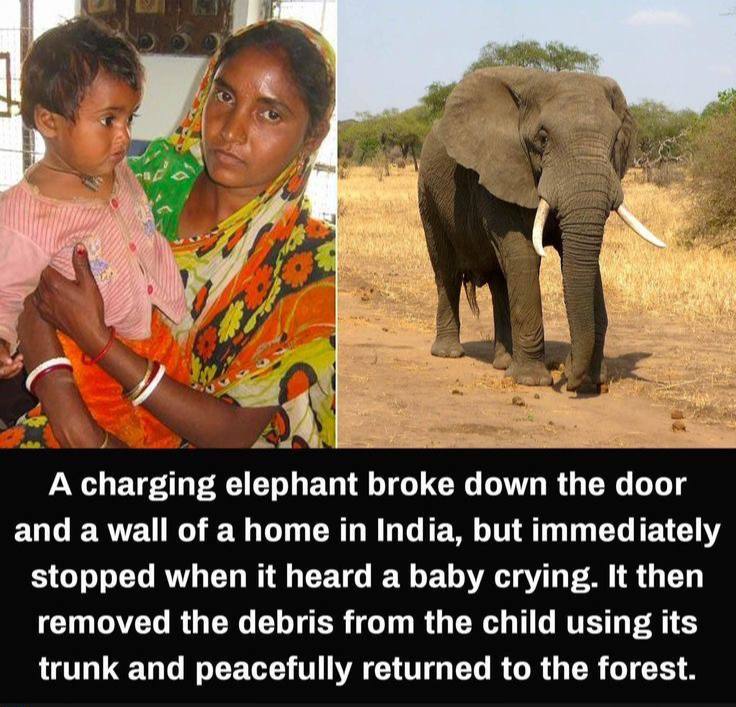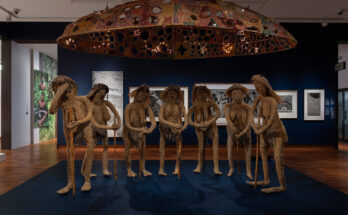
In the heart of rural India, where the edge of the forest blurs into human settlement, a powerful story unfolded—one that reminds us of the mysterious empathy that lies within the animal kingdom. On a seemingly ordinary day, an elephant, agitated or perhaps frightened, charged through a village, breaking down the door and a wall of a humble home. Chaos erupted. But amid the dust and destruction, something extraordinary happened. A sound—a baby’s cry—cut through the tension. And the enormous beast, a force of nature just moments before, paused. What followed was not a display of brute strength, but of unexpected tenderness. Using its massive yet surprisingly dexterous trunk, the elephant removed debris from around the child. It did not panic. It did not roar. It simply looked, listened, and acted with the calm of a protective spirit. Then, as if satisfied with the infant’s safety, it turned and walked back into the forest.
This is not a tale from folklore, nor a modern fable embellished by time. It is a real event, documented by villagers and shared across social media, captivating hearts around the world. This essay explores not only the details of this miraculous encounter but also the deep symbolic and cultural meanings behind it. It delves into the relationship between humans and elephants in India—how these gentle giants are revered, feared, and too often misunderstood. Through ecological, psychological, and ethical lenses, we examine what might have triggered the elephant’s rampage and what, more importantly, might have compelled it to show mercy.
I. The Incident
It was a humid morning in the rural heartlands of India, a region where dense forests blend into modest villages, and the pulse of nature beats close to the rhythm of daily life. In one such village nestled near a wildlife corridor in West Bengal—or perhaps Odisha, as reports often vary—an extraordinary event occurred. A wild elephant, part of a herd known to roam nearby, suddenly broke away and charged into a village house. In its path were fragile mud walls, wooden beams, and the frightened screams of startled residents.
The house it struck was a modest one, barely fortified, with a thatched roof and clay-plastered walls. With one powerful thrust of its tusks and body weight, the elephant tore through the door and a section of the wall, sending bricks and timber flying. Inside the house was a family paralyzed with fear. Amidst the rising dust and the crumbling structure, a baby began to cry.
And then—everything changed.
The elephant froze. Something in the tone of that infant’s cry pierced its fury. In a moment that defied instinct and expectation, the massive creature knelt slightly, reaching out with its trunk. With careful, almost surgical precision, it began to lift pieces of broken wood and debris off the baby, who had fallen between a collapsed cradle and a wall beam. The mother, stunned and weeping, could do nothing but watch in awe. Once the child was uncovered and unharmed, the elephant paused a moment longer, as if ensuring all was well. Then it turned away, walking slowly back into the jungle from which it came.
The house was broken. The wall shattered. But the child lived—unscathed, and perhaps saved by the very being that could have caused the most harm.
II. Elephants and India: A Complicated Coexistence
To those unfamiliar with India’s landscape, the idea of an elephant crashing into a house might seem bizarre or rare. But to the millions living near wildlife reserves and elephant corridors, it is an all-too-common reality. India is home to over 27,000 wild Asian elephants—more than half of the global population. These elephants, although deeply revered in culture and religion, often find themselves in conflict with expanding human settlements.
Urbanization, deforestation, and infrastructure development have fragmented elephant habitats. Ancient migratory paths—used by herds for generations—are now disrupted by roads, railways, and farms. In frustration and confusion, elephants often enter villages in search of food or out of desperation. These incidents can turn deadly: for crops, for property, and tragically, for both humans and elephants.
However, this case was different. This wasn’t just about property damage or a frightened herd. This was about a choice—an animal’s decision to stop, listen, and show mercy. What made this elephant different? Was it a fluke? Or was it something more?
III. The Science of Empathy in Elephants
Animal behaviorists have long suspected that elephants possess a deep emotional intelligence. Studies across Africa and Asia have documented elephants mourning their dead, recognizing themselves in mirrors, and even cooperating with other species. But one of the most fascinating aspects of elephant psychology is their capacity for empathy.
Elephants have been observed comforting distressed peers by touching them with their trunks, vocalizing softly, or even physically supporting them. In captivity, elephants have tried to aid injured humans, showing behaviors akin to concern or care.
Dr. Joyce Poole, a renowned elephant researcher, argues that elephants not only feel complex emotions but can respond to emotional cues in other species, including humans. “When an elephant hears distress—whether from a calf or even a human—it responds. It investigates. Sometimes, it intervenes,” she says.
So when that baby cried—its voice high-pitched, primal, and unmistakably vulnerable—it may have triggered an ancient, evolutionary response in the elephant’s brain. A response rooted not in logic, but in feeling.
IV. Symbolism: The Elephant in Indian Culture
In India, the elephant is not just an animal—it is a deity, a symbol of strength, wisdom, and peace. Lord Ganesha, the beloved elephant-headed god, is invoked before new beginnings, worshipped for removing obstacles and bestowing blessings. Elephants are also central figures in temple ceremonies, religious festivals, and royal traditions.
Villagers often leave offerings for elephants, seeing them as divine messengers. While this reverence does not always prevent conflict, it does underscore the spiritual link many feel with these majestic creatures.
Could this cultural legacy have influenced the elephant’s behavior? Perhaps not directly. But the mutual history shared between humans and elephants in India forms a backdrop for such moments. There exists a language, silent and intuitive, between the two—a legacy of cohabitation, broken only in recent decades by environmental degradation.
In this case, that ancient thread may have momentarily reconnected—reminding both parties of a deeper bond.


